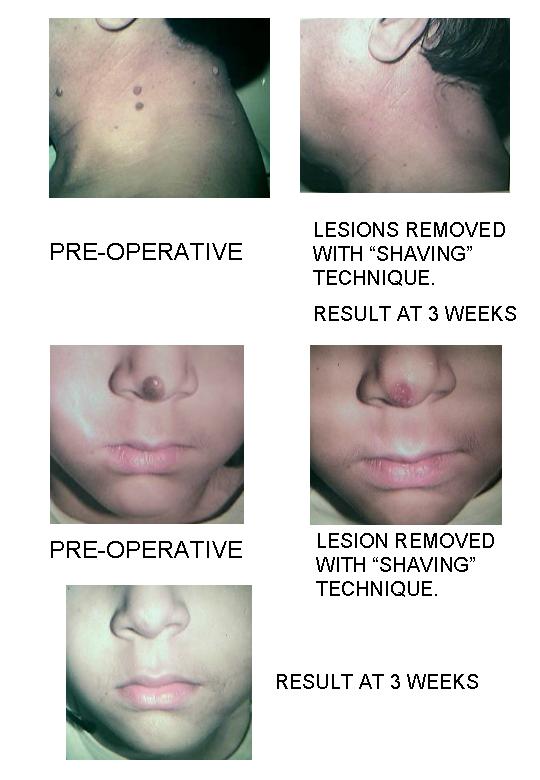Wednesday, October 29, 2003
3384
P22: Advantages of Radiosurgery in Aesthetic Surgery
I.GOALS The purpose of this study was to evaluate our results in aesthetic surgical procedures and removal of superficial skin lesions with the use of radiosurgery and compare them with the scalpel, electrosurgery and laser. II.MATERIAL AND METHODS. Clinical experience and Histological studies. CLINICAL EXPERIENCE: We reviewed 949 cases of aesthetic surgical procedures and removal of 350 superficial skin lesions performed with radiosurgery between November of 1995 and November of 2000. We evaluated bleeding, operating time, healing time, post-operative edema and ecchymosis and quality of the scars. Also complications: infection, dehiscense, skin necrosis, hematomas and seromas. HISTOLOGICAL STUDIES: In 12 skin specimens, a double blind histological study of lateral thermal damage was conducted comparing incisions made with the same Vari-Tip electrode with radiosurgery and electrosurgery. III.TECHNIQUE To perform the incisions, a high radiofrequency equipment of 3.8 Mhz. Surgitron-Ellman was used in all cases. The radiowaves generated by this device travel from the electrode tip to the patient and intracellular boiling fluid, expansion and rupture of the cell membrane is produced without or with very minimal damage to adjacent tissues. Electrosurgery machines that work below 3.0 Mhz. produced excessive thermal effect and tissue damage. Using a high frecuency radiosurgery unit, the degree of lateral thermal effect is in total control of the operating surgeon selecting the other parameters.
Lateral heat = TxPxWxE / F T: time of exporpuse E: electrode size P: power F: frequency W: wave form.
A plate is placed under the patient near the surgical site but it doesn’t require direct contact with the skin. IV.RESULTS CLINICAL EXPERIENCE: Based in a comparison of our clinical observations during the previous 14 years experience using the scalpel and the electrocautery for the performance of all our aesthetic procedures and the recent 5 years experience using high radiofrequency, we have noticed clear differences and advantages of the radiosurgery technique: There is less bleeding and reduced operating time with less post operative edema and ecchymosis. We have not seen increased infections, delayed healing or wound dehiscenses. There is no risk of accidental skin burns because no ground plate in needed. The ocurrence of skin necrosis at the typical flap sites in abdominoplasties and reduction mammoplasties appear to be the same. The post face lift hematomas are less frequent 5 cases or 1.6%, but post abdominoplasty seromas are more often, 7 cases or 20%. Hypertropic scars are less frequent particulary in breast and abdominal surgeries. Because with the Vari-Tip electrode no pressure is applied on the skin whatsoever, very fine and precise straight perpendicular incisions are easily made, without the undesirable beveling occurrence with the scalpel, for example in the periumbilical incisions and alike. With the “shaving technique” for the skin lesion cases, the real operating time was reduced to only a few seconds. The average healing time was 11 days with the minimum of 5 and the maximum of 21 days. There were no hypertropic scars, however 33 complications of minor depressed scars (9%) were present, 2 infections, 17 cases of transient hyperpigmentation and only 5 cases of permanent hypopigmentation. Without elliptical excision there is no traditional lineal scars and a scarless cosmetic result is achieved. HISTOLOGICAL STUDIES: With the electrocautery unit; that works at a maximum of 0.5 MHz frequency; the maximum lateral thermal damage was 170 microns and the minimum of 50 microns with an average of 96 microns. With radiosurgery the maximum was 90 microns and the minimum 25 microns with an average of 65 microns. With respect the CO2 lasers, reports in the literature indicate a lateral thermal damage of 500 to 1000 microns. V. CONCLUSIONS Based in our clinical experience as well as according to histological studies, the use of high radiofrequency (3.8 MHZ) offers several advantages over the scalpel, electrosurgery and CO2 laser with an overall excellent quality scars. Optimal results with this technology requires understanding its principles and a different manual dexterity learning curve.
View Synopsis (.doc format, 401.0 kb)
See more of Posters
Back to Plastic Surgery 2003 Complete Scientific Program
Back to Plastic Surgery 2003 Meeting home

